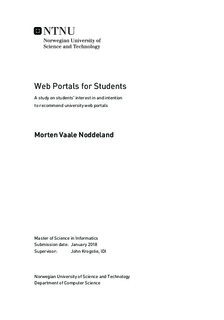Web Portals for Students - A study on students' interest in and intention to recommend university web portals
Master thesis
Permanent lenke
http://hdl.handle.net/11250/2504405Utgivelsesdato
2018Metadata
Vis full innførselSamlinger
Sammendrag
In the autumn of 2013, a website called instabart.no was launched. The website catered to students at NTNU and focused on gathering links to the 12 most useful IT services for students. Within a month of its launch, the website had gained 2200 weekly users, equivalent to 10% of NTNUs student body. The only form of PR was two Facebook posts.
This experience led to a desire to answer two questions:1. Can university web portals similar to Instabart be just as relevant at other universities?2. Is it possible to better explain voluntary adoption of IT services by extending the Technology Acceptance Model?
To answer these questions, two new university web portals were created. The websites were then launched and afterwards promoted via Facebook. Three surveys were conducted, where a total of 214 students tested the web portals before answering a questionnaire. The Technology Acceptance Model (TAM) was extended with a construct called "behavioral intention to recommend". PLS-SEM, short for partial least squares structural equation modelling, was conducted to assess the quality of the new TAM extension.
The results revealed a clear interest in university web portals. Students rated the web portals highly in the survey. The websites did not become as popular as Instabart, but gained a modest amount of loyal users.
The PLS-SEM analysis showed that the construct "behavioral intention to recommend" was significantly affected by three of the models construct: "behavioral intention to use", "perceived usefulness" and "perceived enjoyment". The model also conformed to earlier TAM findings, such as "perceived usefulness" being the strongest predictor of "behavioral intention to use".
